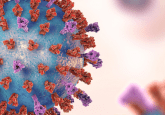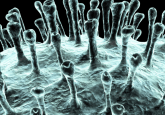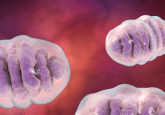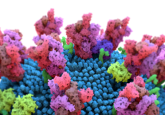Eric Chen: imaging the atomic-resolution structure of coronavirus ‘spike’ protein
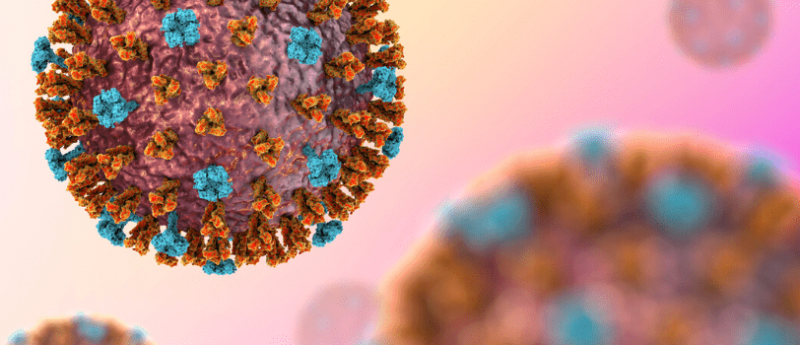
 Eric Chen is a director of market development, Asia Pacific, for Thermo Fisher Scientific. Based in China, Eric is responsible for driving Thermo Fisher’s life sciences electron microscopy business development and growth in Asia Pacific for both academia and pharma.
Eric Chen is a director of market development, Asia Pacific, for Thermo Fisher Scientific. Based in China, Eric is responsible for driving Thermo Fisher’s life sciences electron microscopy business development and growth in Asia Pacific for both academia and pharma.
Why is the spike part of the coronavirus of such interest?
The virus glycoprotein or spike protein of the coronavirus is a key point of engagement with other cells and binds with its human host cell receptor before it takes the cell hostage and begins the process of virus replication. Disabling the spike protein’s binding affinity is key, and the spike has been a focus for vaccine development and as a potential antiviral drug target. Imaging the virus’ spike protein, getting an understanding of its structure, and producing an epitope map of binding sites allows researchers to analyze which antibodies or inhibitors will prevent viral docking. There are thousands of molecules that may respond to therapies, but through data science, researchers may be able to predict which one will work best. Cryo-EM has been instrumental for the research into coronaviruses over the years. The speed at which SARS-CoV-2 protein structures, like its spike protein, were determined is a testament to that and they will hopefully accelerate the research into treatments and a cure for COVID-19.
If you would like to keep up to date with our content on coronavirus, you can sign up for our site here, where you can subscribe to our newsletters for free!
What does cryo-EM bring to the table that other imaging methods cannot?
Previous technologies use diffraction, which is great but can be more challenging, especially around producing high-quality crystals that are large enough to yield a strong signal. Cryo-EM skips the requirement of producing a crystal (which can take years and quite a significant amount of protein), uses the precursor purified protein, and requires very little sample material. The Cryo-EM single particle analysis (SPA) workflow has proved extremely stable going from vitrification to screening, to rapid high-speed, high-resolution imaging. It has benefited from advanced cryo-EM microscopes that provide stable positioning and optics, new detectors that are higher speed and more sensitive and intelligent data acquisition software paired with innovations in reconstruction methods. These recent developments allow researchers in structure-based drug design to quickly produce accurate 3D maps of viruses and other disease-related proteins, develop strategies to prevent and cure illness, and in this case, ultimately accelerate treatments for COVID-19 and other viral diseases.
How do you envision the use of cryo-EM will impact research into new therapeutics going forward?
We continue to innovate in microscope automation, optics, detection, and software to increase the throughput and productivity of our cryo-EM workflows. These innovations allow researchers around the world to resolve more relevant biological samples at higher resolution, faster. We also focus on making cryo-EM accessible to more researchers. Our Thermo Scientific Glacios cryo-TEM, for example, is an affordable standalone SPA data acquisition solution. Our next phase of innovation will be around cryo-electron tomography, which will allow high-resolution imaging at specific locations in a cell. Cryo-electron tomography has the potential to transform structural biology as it can provide insights on macromolecules, such as drug targets, in their native cellular environment.
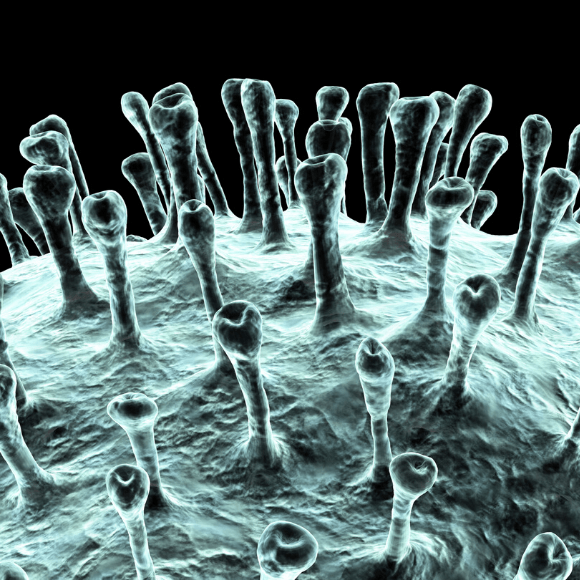 How long can coronavirus remain infectious in the air and on contaminated surfaces?
How long can coronavirus remain infectious in the air and on contaminated surfaces?
New study finds that the novel coronavirus, SARS-CoV-2, can remain viable on plastic and steel for several days, highlighting the importance of hand washing and surface cleaning amidst the current outbreak.
What else is Thermo Fisher involved in at the moment in terms of coronavirus?
Firstly, in terms of detection, as outlined in the recent US CDC Emergency Use Authorization (EUA)-approved protocol, Thermo Fisher is enabling critical instrumentation and consumable components of the protocol.
Thermo Fisher is also working to develop a multi-pathogen test panel that will enable laboratories to differentiate between COVID-19 and sources of infection that present similar symptoms, such as seasonal influenza and other respiratory illnesses.
This new panel follows the release of a qPCR assay, the TaqMan 2019-COVID-19 Assay Kit, which is now shipping to labs for validation and deployment, with priority for China and Southeast Asia. Thermo Fisher is also working on a multiplexed version of its COVID-19 assay that will minimize sample input and increase throughput, enabling labs to process more samples in less time.
To support virus identification and monitoring for possible mutations that could affect testing and treatment, Thermo Fisher developed a custom Ion AmpliSeq next-generation sequencing panel for COVID-19, which runs on its Ion Torrent S5 System. The panel is designed to cover more than 99% of the virus genome, and customers are now validating it with virus samples in China, North America and EMEA.
Second, in terms of prevention, to support rapid vaccine development, Thermo Fisher is providing technologies and services to accelerate bioproduction development and delivery timelines. The University of Queensland (Australia), which mobilized early to develop a COVID-19 vaccine under the auspices of the Coalition for Epidemic Preparedness (CEPI), is among the laboratories using the Gibco ExpiCHO Expression System to rapidly scale development. Thermo Fisher is also available to offer vaccine manufacturing and clinical trial support.
The company’s Krios cryo-electron microscope, the world’s most powerful, commercially available cryo-EM for the life sciences industry, has been used to image the atomic structure of the novel betacoronavirus, helping expedite the development and evaluation of a potential drug. Researchers across the globe have used the Krios to image the spike gaining valuable insight into what potential drugs can connect or bind best, and therefore are most effective.
Finally, in terms of protection, through its Fisher Scientific channel, the company has also prioritized distribution of safety equipment, including respirators, masks and gloves, to protect healthcare workers and those involved in direct patient care.
